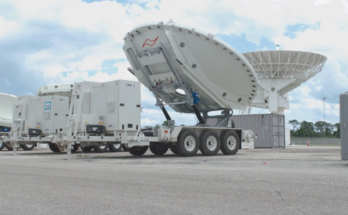by C. Zachary Hofer, Electronics Analyst, Forecast International.
![Airborne Reconnaissance Low-Enhanced (ARL-E). By Mark Harkin (N8200HUploaded by russavia) [CC BY 2.0], via Wikimedia Commons](http://www.defensesecuritymonitor.com/wordpress/wp-content/uploads/2015/12/N8200H_6902694593.jpg)
Under this contract, Leidos will provide the Army with ARL-E design, architecture engineering, configuration management, system integration, testing, and technical and logistics support. It is one of the first major contracts to be awarded under the ARL-E procurement, which the Army first began budgeting in its FY15 requests. The system, based on the Q400 (DHC-8) platform, will eventually replace the older DHC-7-based ARL-M. Eight or nine ARL-Es are eventually expected to be produced, with system deliveries stretching into the early 2020s. An optimistic forecast schedule will not see the first ARL-E delivery until 2018.
In related developments, in September, Northrop Grumman was selected by the Army to begin development of a new Synthetic Aperture Radar/Ground Moving Target Indicator (SAR/GMTI) system for the ARL-E, known as the Long-Range Radar (LRR). At the time, Steve McCoy, vice president of tactical sensor solutions at Northrop Grumman Electronic Systems, said, “Our low-risk, affordable solution combines mature active electronically scanned array [AESA] technology with operationally proven hardware and software to meet all-weather and long-range ISR requirements.”
Northrop Grumman’s LRR will combine aspects of the company’s Generation 2 Vehicle and Dismount and Exploitation Radar (VADER) back-end electronics and software with a new AESA. This approach ensures that Northrop Grumman can meet the rapid pace of ARL-E platform development as currently outlined by the Army. By using the core electronics of an in-use, field-tested system in combination with a new T/R array, Northrop Grumman’s testing period will be shortened considerably. VADER’s software and hardware will only need to be calibrated or scaled to function optimally with the new array’s characteristics.
A fully updated Airborne Reconnaissance Low program report is available as part of Forecast International’s Airborne Electronics Forecast, C4I Forecast, and Electro-Optical Systems Forecast books. Coverage is also included as a part of certain key modules within Forecast International’s revolutionary Platinum Forecast System™ 2.0. In Platinum, users can gain access to Forecast International’s industry-leading forecast database with added customizable charts and graphs, as well as data tables and program reports, all updated on an hourly basis.
For 50 years, Forecast International intelligence reports have been the aerospace and defense industry standard for accurate research, analysis, and projections. Our experienced analysts compile, evaluate, and present accurate data for decision makers. FI's market research reports offer concise analysis of individual programs and identify market opportunities. Each report includes a program overview, detailed statistics, recent developments and a competitive analysis, culminating in production forecasts spanning 10 or 15 years. Let our market intelligence reports be a key part of reducing uncertainties and mastering your specific market and its growth potential. Find out more at www.forecastinternational.com




